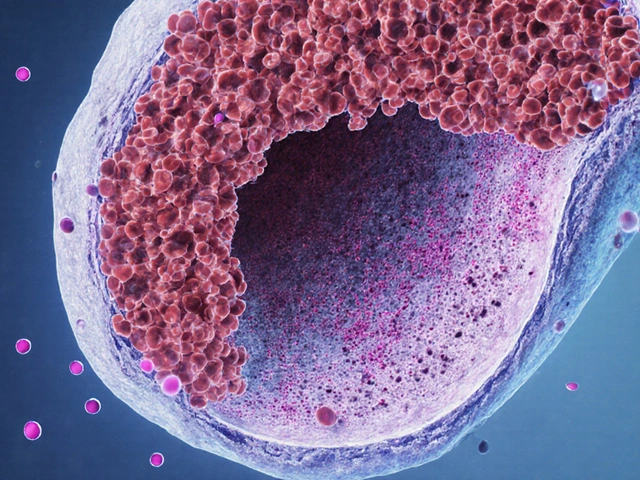- Home
- ::
- How Many Hours Should a 55-Year-Old Woman Fast to Lose Weight?

How Many Hours Should a 55-Year-Old Woman Fast to Lose Weight?
Fasting as a weight loss tool has gained loads of attention over the past few years. If you're a 55-year-old woman wondering how this might work for you, you're in the right place. It's not just about skipping meals, but doing it in a way that fits your lifestyle and health needs.
So, how does fasting work? When you fast, your body uses the stored energy in your fat cells for fuel. This can help lose weight. But those new to it often ask, 'How long should I fast?' Well, the answer can vary depending on personal health conditions and weight loss goals.
For many women in their mid-fifties, intermittent fasting is a popular choice. This type of fasting involves eating during a specific time window and fasting the rest of the day. An often recommended schedule is the 16/8 method, which involves fasting for 16 hours and eating during an 8-hour window.
- Understanding Fasting
- Different Types of Fasting
- Ideal Fasting Duration for 55-Year-Old Women
- Health Benefits and Considerations
- Practical Tips for Successful Fasting
Understanding Fasting
At its core, fasting is about giving your body a break from eating and allowing it to use stored fat for energy. This is why it's often a great tool for weight loss. Our bodies are built for this - back in the hunter-gatherer days, there were times when food wasn't always available, and humans adapted to thrive during these periods without constant meals.
Why Consider Fasting at 55?
The body's metabolism slows down as we age, which is why many find it harder to shed those extra pounds over 50. Intermittent fasting can help rev up this sluggish metabolism. Plus, studies have shown that fasting can improve insulin sensitivity, which is crucial for losing weight effectively.
Types of Fasting
There are several ways you can go about fasting:
- Intermittent Fasting (16/8 Method): Fast for 16 hours, eat during an 8-hour window.
- 5:2 Method: Eat normally for 5 days a week, little to no food on the other 2 days.
- Eat-Stop-Eat: Pick one or two non-consecutive days per week when you don't eat at all for 24 hours.
Benefits Beyond Weight Loss
Fasting isn't just about shedding pounds. It might reduce inflammation and promote heart health. In some studies, participants noted better mental clarity and increased energy levels.
| Health Benefit | Impact |
|---|---|
| Weight Loss | Boosts fat burning processes |
| Insulin Sensitivity | Improved glucose management |
| Mental Clarity | Increase in focus and energy |
It's important to note that fasting should be approached thoughtfully, especially for those on medications or with specific health conditions. Always consider consulting with a healthcare provider before jumping in. After all, the goal is to feel good and stay healthy while losing weight.
Different Types of Fasting
Fasting isn't one-size-fits-all, and there's actually quite a buffet of approaches to choose from. Let's break down some popular ones you might consider as a 55-year-old woman looking to lose weight.
Intermittent Fasting (IF)
This one’s a favorite for many. The idea is simple: cycle between periods of fasting and eating. The 16/8 method is a popular choice where you fast for 16 hours and then eat during an 8-hour window. Another one is the 5:2 diet, where you eat normally for five days and then restrict calories to about 500-600 for two non-consecutive days. These can fit into a busy lifestyle pretty easily, allowing you more freedom to enjoy your meals some days.
Alternate-Day Fasting (ADF)
This involves fasting every other day. On fasting days, you either don't eat at all or have a very limited calorie intake. It might sound a bit harsh, but some find this routine easier to handle since you get to eat normally every other day.
Eat-Stop-Eat
Created by a fitness expert, this type advises fasting for 24 hours once or twice a week. So, if you finish dinner at 7 PM, you won’t eat again until 7 PM the following day. The idea is simple and very straightforward.
Extended Fasting
That's fasting for more than 24 hours – could be two days, three days, or more. But be warned, this isn't for everyone and should ideally be done under medical supervision, especially if you're not experienced. It's crucial to listen to your body and ensure you're getting essential nutrients once you break the fast.
Fasting Mimicking Diet
This is a newer approach where instead of not eating, you eat very low-calorie, plant-based foods for a few days. It tricks your body into thinking it's fasting while still getting some nutrition.
Choosing the right type of fasting depends on how well each fits into your life and your specific health needs. Always remember, if you're considering making significant changes like fasting, it’s best to chat with a healthcare professional to make sure it’s safe for you.

Ideal Fasting Duration for 55-Year-Old Women
When it comes to figuring out the ideal fasting duration for a 55-year-old woman, there are a few things to consider. The 16/8 method is a popular choice, but flexibility is key. It means you fast for 16 hours and have all your meals in the 8-hour eating window. This might look like skipping breakfast and eating between noon and 8 PM.
Why 16 hours? It's long enough to allow your body to switch from burning sugars to burning fats, but short enough to be manageable for most people. However, some may find starting with a 12/12 fasting duration easier and can gradually increase the fasting period as they get used to it.
Listen to Your Body
It's crucial to pay attention to how your body reacts. Every person is different. What works for one might not work for another. Some women in their fifties have more energy and better concentration when they fast, while others may feel tired or moody.
Health Considerations
If you have underlying health conditions such as diabetes or cardiovascular issues, consult with a healthcare professional before starting any fasting routine. They'll help you tailor a fasting schedule that aligns with your health needs.
Sample Fasting Schedules
| Fasting Method | Fasting Period | Eating Window |
|---|---|---|
| 16/8 Method | 16 hours | 8 hours |
| 12/12 Method | 12 hours | 12 hours |
| 5:2 Method | 2 days a week with limited calories | Normal eating on other days |
Whatever method you choose, the goal is to create a plan that fits your life and supports your weight loss goals. Adjust timings as needed and find what gives the best results for your health and energy levels.
Health Benefits and Considerations
When it comes to fasting, it's not just about losing weight. There are several health benefits and things you need to think about, especially as a woman entering her mid-fifties.
Potential Benefits
One big perk of fasting is improved metabolism. By giving your digestive system a break, your body can use energy more efficiently. There's also evidence suggesting that intermittent fasting can lower inflammation, which plays a role in many chronic conditions. Keep in mind that these benefits can help when you're trying to shed those extra pounds.
Additionally, fasting can support heart health by reducing cholesterol levels and improving blood sugar regulation. For many, maintaining heart health is crucial as they age.
Things to Consider
Before you jump into fasting, remember that it's not a one-size-fits-all approach. Intermittent fasting might not be suitable for everyone. If you have underlying health conditions or take medication, it's wise to chat with a healthcare professional.
- Keep hydrated: It’s easy to forget water when you're not eating, but staying hydrated is crucial.
- Watch your nutrition: When the fasting window ends, make sure your meals are balanced to nourish your body.
- Listen to your body: Feelings of dizziness or fatigue might mean you need to adjust your fasting schedule or approach.
| Age Group | Average Caloric Needs |
|---|---|
| 31-50 years | 1,800-2,200 calories/day |
| 51+ years | 1,600-2,200 calories/day |
Remember, weight loss is more than just fasting. It's about maintaining a healthy lifestyle that includes exercise, balanced eating, and occasionally giving your system a rest through fasting. Always balance the benefits with your personal health considerations.

Practical Tips for Successful Fasting
Jumping into fasting without a plan? That's like setting out on a road trip without a map. Here are some practical tips to make your fasting journey a bit smoother.
Start Small
If you're new to fasting, ease into it. Try starting with a shorter fasting window, like 12 hours, and gradually increase it to the popular 16/8 method. Your body needs time to adjust, so give it that.
Stay Hydrated
Drinking water is super important. It keeps hunger pangs at bay and helps your body function properly. You might think you're hungry, but sometimes you're just thirsty.
Choose the Right Time Window
Pick your eating window wisely based on your daily routine. If you usually have a social dinner, make sure your eating hours fit that. It's about making intermittent fasting work for your lifestyle.
Don’t Skip Nutrients
When you do eat, focus on getting a balanced diet. Load up on proteins, healthy fats, and plenty of veggies. Your food should fuel you up for the hours you won't be eating.
Listen to Your Body
Your body speaks—hear it out. If you're feeling extremely tired or unwell, fasting might not be working out for you. Adjust as needed. There's no one-size-fits-all.
| Fasting Duration | Calories Consumed |
|---|---|
| 12 Hours | 1800 kcal |
| 16 Hours | 1500 kcal |
Women often aim for around 1500 to 1800 calories depending on activity level. So, fasting effectively means managing your intake smartly.
These are just starting points. As with any lifestyle change, especially involving diet, check with a healthcare provider to suit your individual needs and conditions. Good luck!

 Health and Wellness
Health and Wellness





Write a comment